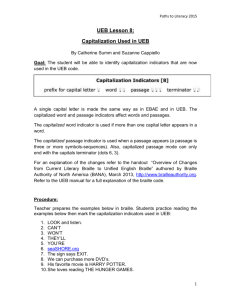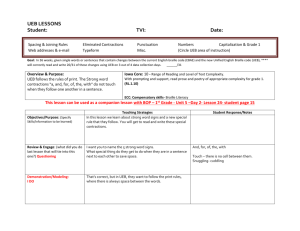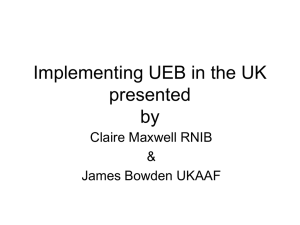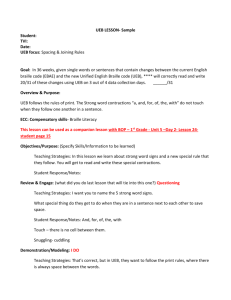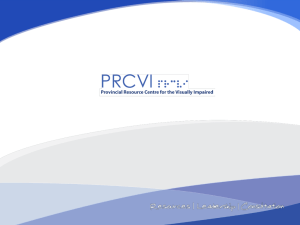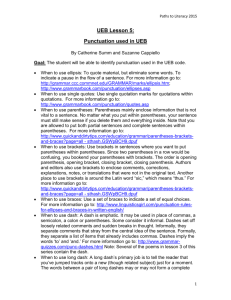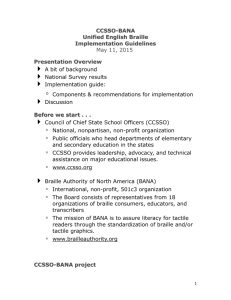Comparing SEB and UEB
advertisement
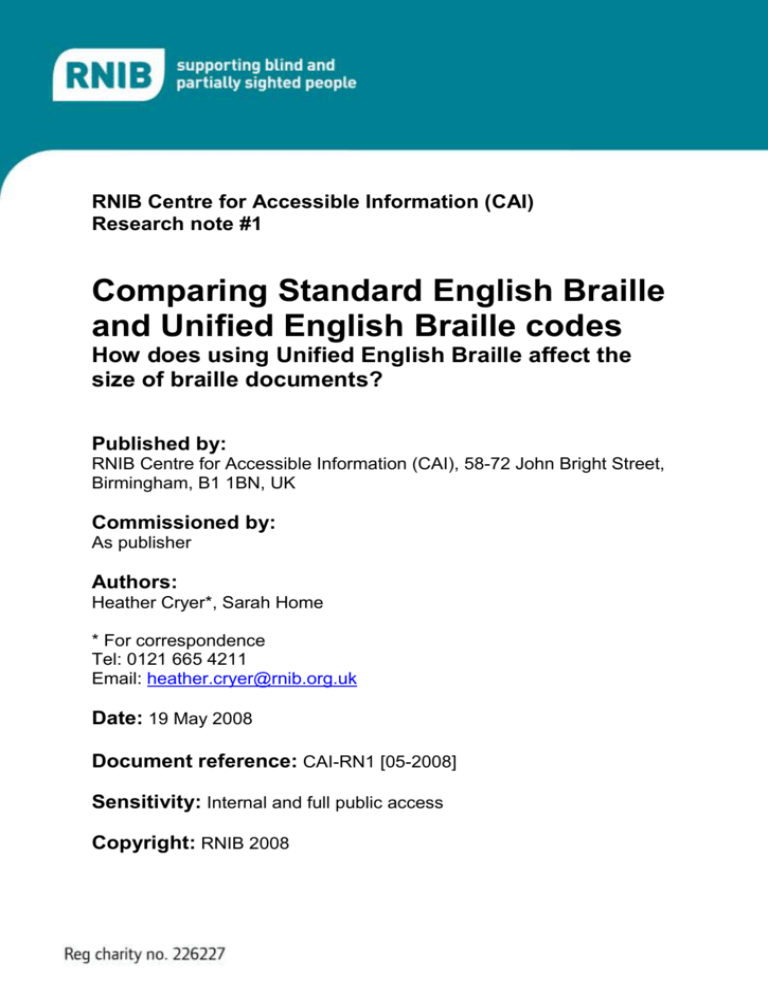
RNIB Centre for Accessible Information (CAI) Research note #1 Comparing Standard English Braille and Unified English Braille codes How does using Unified English Braille affect the size of braille documents? Published by: RNIB Centre for Accessible Information (CAI), 58-72 John Bright Street, Birmingham, B1 1BN, UK Commissioned by: As publisher Authors: Heather Cryer*, Sarah Home * For correspondence Tel: 0121 665 4211 Email: heather.cryer@rnib.org.uk Date: 19 May 2008 Document reference: CAI-RN1 [05-2008] Sensitivity: Internal and full public access Copyright: RNIB 2008 © RNIB 2008 Citation guidance: Cryer, H. and Home, S. (2008). Comparing Standard English Braille and Unified English Braille codes. RNIB Centre for Accessible Information, Birmingham: Research note #1. Acknowledgements: Thanks to Stephen Phippen and George Bell who carried out the comparisons, and to Sarah Morley Wilkins for editorial input. CAI-RN1 [05-2008] 2 © RNIB 2008 Comparing Standard English Braille and Unified English Braille codes Research note #1 Word count 1026 RNIB Centre for Accessible Information (CAI) Prepared by: Heather Cryer (Research Officer, CAI) Prepared for: UEB working group Based on comparisons carried out by: George Bell (Managing Director, Technovision) Stephen Phippen (Standards and Software Implementation Officer, Technical Development/CAI, RNIB) FINAL report © RNIB 19 May 2008 Abstract Comparisons were carried out to determine to what extent using the Unified English Braille code (UEB) affects the physical size of a document when compared to braille currently used in the UK. Comparisons included both literary braille documents and items using technical braille notations. Findings suggest that the use of UEB may increase the size of technical publications, although the extent of this increase will depend on the complexity of the material. With literary braille, the majority of the increase in space used by UEB is due to capitalisation. Compared to capitalised UK braille, the additional increase in space due to UEB is very small (1 extra page for every 50 pages). Background In the early 1990s the International Council on English Braille (ICEB) was formed, with a view to creating a Unified English Braille code (UEB). The term "unified" refers to the code design, which represents both literary and technical information using one code. It can also be thought of as indicating a union between English speaking countries using the same code. CAI-RN1 [05-2008] 3 © RNIB 2008 In proposing changes to the braille code, a likely concern for users is the effect of any changes on the physical size of documents. This research note presents results of some initial comparisons of the length of UEB outputs compared to the literary and technical codes currently used in the UK. Part 1 - Literary code Procedure A variety of literary publications - from short leaflets to novels - were produced in 2 forms of Standard English Braille (SEB) (capitalised and non-capitalised, which are both used in the UK) and in UEB. All materials were formatted with 40 cells per line and 25 lines per page. Outputs were compared to determine any differences in space used by the different braille codes. Two measures were taken - percentage increase in lines and percentage increase in pages. Findings in literary publications Comparing capitalised and non-capitalised SEB: Using capitalised SEB increased the number of lines by 3.50% on average Using capitalised SEB increased the number of pages by 3.46% on average (or by one extra page every 29 pages) Comparing UEB and non-capitalised SEB: Using UEB increased the number of lines by 5.67% on average Using UEB increased the number of pages by 5.5% on average (or by one extra page to every 18 pages) Comparing UEB and capitalised SEB: Using UEB increased the number of lines by 2.10% on average Using UEB increased the number of pages by 1.97% on average (or by one extra page to every 50 pages) These findings show that the majority of the increase in space used by UEB is accounted for by capitalisation. In comparison to capitalised SEB, the further increase of UEB is very small. CAI-RN1 [05-2008] 4 © RNIB 2008 Part 2 - Technical codes Procedure Extracts from two maths textbooks (higher maths and elementary maths), a computing book and a chemistry textbook were used in this study. These materials were produced in both SEB (using relevant technical notations where appropriate) and UEB (which uses the same notation for literary and technical information). The materials reviewed contained the following proportions of technical characters: Higher maths: 27% maths characters Elementary maths: 52% maths characters Chemistry: 18% chemistry characters Computing: 65% computing characters (including format indicators) Note: these are the character proportions for SEB versions. All materials were formatted with 38 cells per line and 28 lines per page. Outputs were compared to determine any differences in space used by the different braille codes. Measures taken were the percentage increase in number of text characters, technical characters, total characters, and lines. (Note: These comparisons were carried out in 1995. Though it is thought that UEB has not undergone any changes likely to significantly affect the results, this data should be checked under current UEB rules) Findings in technical publications Maths The two maths books varied in terms of the effect UEB had on length of output. For the higher maths textbook UEB increased the percentage of maths characters by 21%. For the elementary textbook (which contained a limited range of basic notation), using UEB decreased the percentage of maths characters by 6%. This shows that in UEB more complex maths notation may be depicted using more multi-cell signs. For both maths books, the percentage increase in text characters was 6%. As both books used large amounts of text as well as technical characters, this resulted in a 10% increase in total characters for the higher maths book and no overall increase for the elementary book. CAI-RN1 [05-2008] 5 © RNIB 2008 Computing UEB increased the number of computer characters by 25% compared to the current UK computing code. However, the effect on the physical size of the document was small, with only a 4% increase in the number of lines. This is explained by the fact that many lines are short in computer programs, absorbing the effect of increased numbers of characters. These findings show that whilst UEB does use more characters to represent computer notation, the effect on physical space used is small. Science UEB increased the percentage of chemistry characters by 47% compared to the current science notation. However, as the extract was primarily text, the overall character increase was 12%. This shows that whilst UEB does increase the space taken by technical science characters, the effect on the overall physical size of the document will depend on the proportion of text characters. Conclusions The use of UEB may increase the physical size of publications which include technical information, although the extent of this will depend on the complexity of the material. With regards to literary braille, the majority of the increase in space used by UEB is due to capitalisation. Compared to capitalised SEB, the additional increase in space due to UEB is very small (1 extra page for every 50 pages). CAI-RN1 [05-2008] 6
